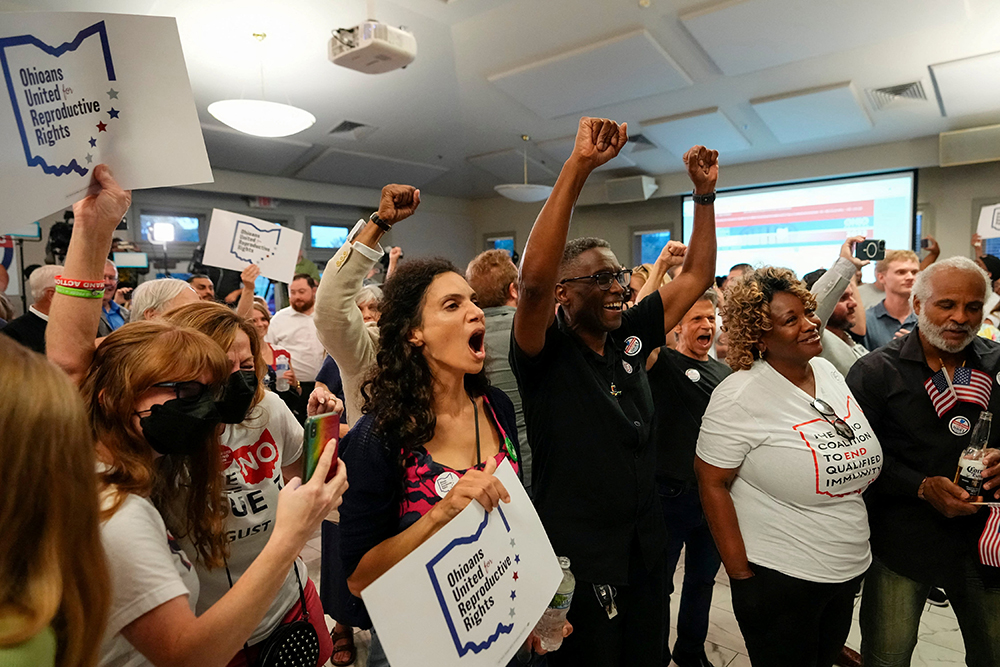
PROSPECT HEIGHTS — While the head of the Ohio Catholic Conference acknowledges the tall task ahead of defeating a pro-abortion amendment to the state’s constitution this fall, he doesn’t agree that the recent rejection of a measure that would have helped defeat the amendment means the battle is already lost.
“We certainly did not see it as a pure proxy vote,” Brian Hickey, executive director of the Ohio Catholic Conference, which represents the state’s bishops, told The Tablet. “We know our work is cut out for us to defeat the abortion amendment in November, but we don’t see it as an impossible task.”
On Aug. 8, more than three million Ohioans took to the polls to vote on Issue 1, a measure that essentially would have made it more difficult to change the state’s constitution by requiring a 60 percent supermajority threshold to pass future constitutional amendments, opposed to the current simple majority.
The measure was rejected by a 57 % to 43% margin, with about 1.7 million people voting against it, and about 1.3 million people in favor. For those opposed to the Republican-backed measure, the result was hailed as a win for democracy by preserving the power of voters. President Joe Biden said that the measure was a “blatant attempt to weaken voters’ voices.”
“Ohioans spoke loud and clear, and democracy won,” Biden said in a statement.
Conversely, supporters argued the measure was important to protect Ohio from out-of-state special interest groups who are trying to influence constitutional changes.
With the abortion amendment vote three months away, the Issue 1 vote was seized upon by both pro-abortion and pro-life advocates. The former advocated that voters reject the measure to maintain a better chance of passing the November abortion rights amendment, and the latter advocated that people pass the measure to diminish the likelihood that the abortion amendment will pass.
Ohio Secretary of State Frank LaRose, a Republican proponent of Issue 1, said back in May that Issue 1 is “100%” about staving off the pro-abortion cause.
The Ohio Catholic bishops never took a stance on Issue 1, officially remaining neutral. They didn’t advise the faithful how to vote, just that it is their civic duty to do so, Hickey said, explaining that “we had a responsibility to make sure Catholics knew that the election was happening.”
“The Catholic bishops didn’t want to take a stance because the August election was purely a procedural election of how to amend the constitution … it’s not a moral question in and of itself,” Hickey said. “It’s a procedural question, hence we do not have a stance to take one way or another.”
The Diocese of Columbus, however, took a different line. A spokesperson for the diocese denied a Tablet request for comment from Bishop Earl Fernandes, but acknowledged in a statement that “we certainly hoped for a different result in the Ohio special election.”
“In cooperation with the Catholic Conference of Ohio and the other Ohio dioceses, we will work toward defeating this hellborn abortion amendment in November,” the spokesperson added.
The Ohio bishops issued a letter in February opposing the abortion amendment, and mailed out prayer cards and fliers explaining its harm. Hickey said they now plan to distribute more resources denouncing the amendment, will have priests speak about it from the pulpit, and launch other initiatives.
“I’m not naive in thinking that yesterday’s result further confirms that we have our work cut out for us to defeat the abortion amendment,” Hickey said. “But we’re going to have a big push.”
The question remains of just how much the Issue 1 vote is a harbinger of what will happen in November. Part of Hickey’s belief that it wasn’t a proxy vote comes from some of the voters the conference has heard from, he said, who reported they rejected Issue 1 because they think it would’ve hurt the democratic process, but who are also pro-life and plan to vote against the abortion amendment.
Dr. Stephen Krason, Chair of the Franciscan University of Steubenville Department of Political Science, told The Tablet that the vote doesn’t necessarily show a clear pro-abortion sentiment in the state, but instead that people were likely motivated to preserve a constitutional process that’s been in place since the 1850s.
“When you’re talking about a significant constitutional change, people are not going to be readily eager to jump aboard the bandwagon to make that change when it seems like you’re restricting in some way the ability of the people by referendum to change the state constitution,” Krason said. “Many people are going to oppose it for that reason. People are going to think it’s restricting popular sovereignty.”
The abortion aspect aside, Krason added that the notion that Issue 1 was an outright negative for democracy is misguided. He said that a constitution isn’t supposed to be treated like a “piece of legislation,” and that because of the simple majority threshold the Ohio constitution has been amended 172 times since it was enacted in 1851. By comparison, the U.S. Constitution, with a much more rigorous amendment process, has been amended only 27 times since it was enacted in 1789.
“America is not a democracy. Our founding fathers established a democratic republic. It’s not meant to be a runaway majority rule. [It’s supposed to be] majority rule with minority rights,” Krasen explained. “The Ohio constitution has maybe been flawed from the beginning with this 50% thing. You think it would be a little bit more difficult to change a state’s fundamental document than that.”
